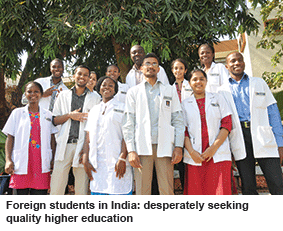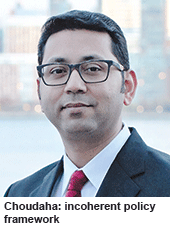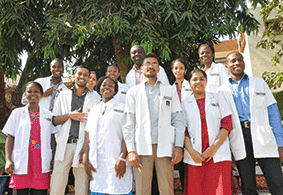In India’s 37,000 undergrad colleges and 744 universities — some of 150 years vintage — the number of foreign students aggregated a mere 66,885 in 2015, an almost 30 percent drop from 93,693 in 2013: Summiya Yasmeen

Within nexgen student communities around the world, there’s rising awareness of the newly emergent global marketplace facilitated by easy jet travel and unprecedented flow of international capital to emergent nations for high returns. But following decades of under-investment in education, India’s HEIs — none of them are ranked in the Top 100 World University Rankings of the London-based Times Higher Education and QS — are ill-equipped to attract foreign students. Heavily regulated by Central and state governments and plagued with outdated curriculums, faculty shortages, and offering abysmal infrastructure and residential accommodation, India’s institutions of higher education have been banished to the corners of radar screens of ambitious students around the world.
Therefore, the great majority of foreign students who opt for relatively inexpensive higher education in India come from the developing nations of Afro-Asia (Afghanistan, Bangladesh, Nepal, Sri Lanka, Kenya, Tanzania, Sudan, Yemen, etc) where HEIs are few and comparatively under-developed, and lack trained faculty. In 2014, a mere 3,737 students from developed countries — USA, Germany, France, South Korea, Australia, China and Singapore — enrolled in India’s institutions of higher education. Against this, there’s an annual migration of an estimated 169,000 students from India to universities and colleges abroad particularly in the US and UK, notwithstanding unimaginably high tuition fees, humiliating visa procedures and the prospect of ice-cold winters. In the US, Indian students (132,000) represent the second largest number of foreign nationality scholars.
“Choosing study abroad destinations and institutions is based on several direct and indirect considerations. Among them is the perception of the destination country and its higher education institutions. Thus far, socio-political and economic factors have not been in favour of India. In sharp contrast, China’s HEIs have benefited from the Peoples Republic’s fantastic growth story and from policy and financial support of government. Indian higher education suffers from lack of focus on quality and an incoherent policy framework. The great majority of globally mobile students are searching for decent quality education at affordable price. India has immense potential to become a hub of students from Asia and Africa if it focuses on quality upgradation and evolves a transparent information dissemination policy for internationally mobile students,” says Dr. Rahul Choudaha, principal researcher and CEO of DrEducation, a US-based global higher education research and consulting firm.
Within the hitherto centrally planned Indian economy in which files-pushing bureaucrats pass off as intellectuals, government policies and control-and-command regulations are the root causes of the huge outward flow and tiny inward trickle of students desperately seeking quality higher education. During the past six decades since independence, the nation’s politicians and bureaucrats have adversely impacted higher education by freezing tuition fees, interfering with faculty selection and curriculums and making colleges and universities completely dependent upon grudging government grants and hand-outs. The outcome of persistent Central and state government interference is that the country’s HEIs, particularly 389 public universities, have not been able to improve infrastructure, attract sufficiently qualified and competent faculty or provide modern residential accommodation — prime concerns of foreign students.
“Many publicly funded research and teaching institutions such as TISS need funding for upgrading infrastructure and building modern hostels. Without increased funding, we are unable to create the appropriate environment for foreign students. Also, most foreign students want the flexibility to transfer course credits to their home countries, which we cannot offer. We need to first create a conducive environment to attract international students,” says Dr. S. Parasuraman, director of the Tata Institute of Social Sciences (TISS), Mumbai, widely acknowledged as India’s premier institution for higher education and research in the social sciences. Currently, TISS (Mumbai) has an enrolment of 2,000 students including 300 foreign scholars from 27 countries who have to rent local accommodation as TISS doesn’t provide hostel facilities (see box p.76).
Over the past two decades, the number of private universities in India has grown from 167 in 2011 to 355 currently. Promoted by edupreneurs with deep pockets on large campuses offering globally comparable infrastructure and internationally benchmarked academic, sports, and residential facilities, India’s private universities are attracting a rising number of domestic and international students. For them, foreign students are valuable — they fill capacity, enable student body diversity, and willingly pay relatively higher tuition and residential fees. The suppressed truth is that the country’s 355 private universities and 7,000-plus professional colleges are majorly responsible for the almost 400 percent jump in the number of foreign students coming to India over the past decade — from 8,145 in 2003 to 66,885 in 2015.
A pioneer institution in attracting students from abroad is Manipal University (MU), which provides medical, engineering, business and hotel management, pharmacy, nursing and paramedical education to 30,000 students in its 22 colleges, and is ranked India’s #1 private varsity in the latest EW India Private University Rankings 2016. Conferred deemed university status in 1993, MU currently hosts 2,200 foreign students from 59 countries worldwide on its state-of-the-art 600-acre campus. It’s astonishing but true that 25 percent of medical practitioners in Malaysia have graduated from its Kasturba Medical College.
The phenomenal success of MU in attracting foreign students to its colleges for several decades is attributable to continuous promotion (MU participated in international road shows in Tanzania, Indonesia, Dubai, Sri Lanka, etc last year), provision of facilitation services (visas, permits, etc), simplified (online) admission procedures, and most importantly, construction of arguably the finest institutional residential accommodation for students including air-conditioned, fully-wired shared and single rooms with attached bathrooms.
“While the number of foreign students coming to India might have dropped, in Manipal University there’s been a steady increase in their number. In addition to full-time students, last year we hosted 600 exchange students from abroad. High-quality education, top-notch faculty, modern classrooms and labs, air-conditioned hostels, multi-cuisine dining, recreational and sports facilities, have contributed to MU becoming the favourite destination of international students in India,” says Dr. Ramjee B, director of international collaborations at Manipal University.
Following Manipal’s example, several new-millennium private universities including Amity, O.P. Jindal, and VIT, among others are making concerted efforts to promote themselves abroad. “A growing number of private universities stage road shows abroad and are actively recruiting overseas students. This new crop of capital-intensive private universities have to attract foreign students to survive and grow. Their relatively affordable fees and high quality of professional education is attracting a rising number of foreign students to India,” says Satya Narayanan R, chairman of CL Educate Ltd, which runs 146 test-prep centres under the name and style of Career Launcher, eight K-12 schools (Indus World Schools) and 28 vocational training centres countrywide.
According to Sanjeev Bolia, promoter-director of Afairs Exhibitions & Media Pvt. Ltd which stages its Great India Education Fairs (road shows in which Indian schools and colleges showcase themselves) annually in eight foreign countries viz, UAE, Thailand, South Korea, Malaysia, Nepal, Bhutan, Bangladesh, and Sri Lanka, over 100 private education institutions from across India participated in its fairs in 2015. “We have successfully marketed India’s top-ranked schools through our road shows in India, the Middle East and South-east Asia. Through our Great India Education Fairs we are promoting HEIs, and believe that private HEIs can be the game changers in transforming India into a hub of higher education of Asia. The main reason why India has not yet emerged as a preferred destination of foreign students is because neither the Central nor state governments have bothered to promote and market our education institutions. On the other hand, even small countries like Singapore and Dubai have professional organisations to promote their education institutions abroad. It’s important for government to acknowledge that India’s best universities offer the advantages of high-quality English medium education at one-fifth the price of university education in Western countries. The India education brand has great saleability particularly in Asia and Africa. Therefore, we need to market it well,” says Bolia.
Fortunately there seems to be a belated awareness within the Union HRD ministry that it’s doing too little to promote Indian education institutions abroad. According to media reports the ministry plans to launch a ‘Study in India’ campaign to attract foreign students to India.
Promoted in 1950 by Maulana Abul Kalam Azad, independent India’s first education minister to promote cultural diplomacy, ICCR offers 3,350 scholarships per year to foreign students to study in India’s HEIs. However, apart from offering scholarships — most of which cover study of traditional disciplines such as Indian dance and music, Ayurveda, yoga, etc — the government-funded council has done little to promote Indian higher education abroad and/or offer assistance to foreign students already in India.
In April, ICCR attracted criticism for releasing a handbook for foreign scholars living in India, which projects the country as regressive. “Educated women have cast aside many customary inhibitions and have come forward in many ways in the past few decades. They will talk to the student when he is introduced to them. The modern Indian woman is traditional in some ways. She may refuse politely if a man asks her out for a film or an outing. Dating is not common in India,” says the handbook.
Further, the handbook in effect admits that residential accommodation in India’s HEIs is inevitably substandard. “Rooms are allotted on a first-come-first-served basis and there is a shortage of rooms in most Indian universities… It is better to avoid getting a room near bathrooms or right under the roof (as it can get very hot in the summers). Sometimes, in case of some hostels, limited hours of water supply and frequent power cuts make a stay in an Indian hostel quite a challenge.”
Though nationalists have balked at 21st-century India being portrayed in negative light, a cross-section of foreign students interviewed by EducationWorld correspondents countrywide concur with the caveats of ICCR’s “updated” handbook. From rote-centric pedagogies to poor residential accommodation, difficulty in renting flats and unfriendly natives, the student interviews provide valuable insights on studying and living in India.
Add to these challenges of studying in Indian HEIs, the new phenomenon of racist attacks on African students by urban lumpens. On February 3 a mob attacked, assaulted and stripped a 21-year-old Tanzanian woman student in Hessarghatta, a semi-rural suburb on the outskirts of Bangalore which hosts half-a-dozen higher educational institutions where a large number of African students — including 150 from Tanzania — study. More recently on May 21, a Congolese postgraduate student was beaten to death by a mob in Delhi.
Unsurprisingly, the rising incidence of mob attacks on African students — and the pusillanimous response of police, Central and state governments — has escalated into a major diplomatic row with ambassadors of several African countries boycotting the Africa Day celebrations hosted by ICCR on May 26. In a statement released on May 25, they deplored Indian “racism and Afro-phobia” and said that “the African community in India, including students are in a state of mourning”. Curiously neither the ministry of external affairs nor the Indian public seem aware that casual response to racial discrimination and violence against African students could invite retaliatory violence against the estimated 500,000-strong Indian communities residing in several African countries. Indeed mob attacks on Indians in Kinshasa (Congo) are reported as we go to press.
Paradoxically, even as the country’s institutions of higher education are failing miserably on the barometer of international student satisfaction, India’s new genre five-star international schools are emerging as preferred destinations of foreign students.
Defined by globally benchmarked infrastructure including contemporary en suite residences and sports facilities, top-notch faculty and affiliations with international examination boards such as IBO, Geneva and CIE, UK, the country’s estimated 600 international schools are attracting an increasing number of foreign and NRI (non-resident Indian) students eager to avail competitively priced, globally accepted English-medium schooling.
Quite clearly, for India to emerge as a favoured higher education destination for foreign students, the country’s tertiary education system needs to be freed from stifling government supervision and regulation. Academic and financial autonomy will enable HEIs to recruit international faculty, improve teaching-learning standards, and raise tuition fees to fund expansion and upgradation of academic as well as residential facilities.
“Currently our higher education institutions are highly regimented. We need greater freedom to adopt innovative teaching, learning and evaluation systems and greater operational flexibility. Academic, IT, sports and residential facilities in most of India’s colleges and universities are way below international standards. Residential accommodation is below par and cuisines are entirely local. Colleges and universities should be given financial autonomy and allowed to raise fees and resources to invest in world-class infrastructure and residential accommodation. India has the potential to become a hub of foreign students particularly from Asia and Africa. To realise this potential, the government needs to enable and facilitate an academic quality and infrastructure upgradation drive in our institutions of higher education,” says Dr. S. Vaidhyasubramaniam, dean of planning and development of Shanmugha Arts, Science, Technology & Research Academy (SASTRA) University (estb.1984), Thanjavur district (Tamil Nadu).
Though there’s a dawning awareness within the Central government and HRD ministry of the importance of attracting larger numbers of foreign students into India’s HEIs, there isn’t a corresponding sense of urgency about readying and upgrading the country’s 35,000 colleges and 744 universities to international standards. In a rapidly globalising world, it is not only important to attract foreign scholars to study here but to also ensure they return home with positive images of the country, which will result in trade and commerce and diplomatic benefits in the long-term. Higher academic standards and upgraded facilities will benefit not just foreign but also the country’s 27 million shortchanged tertiary students floundering in shallows and misery.
With Hemalatha Raghupathi (Chennai), Dipta Joshi (Mumbai), Swati Roy & Autar Nehru (Delhi) & Baishali Mukherjee (Kolkata)
